01.11.2004
M.Dvoretsky. Positional sacrifice of the Queen (continuation 3)
Chesny – Gulko C16
Somerset 1986 42/357
1.e2-e4 e7-e6
2.d2-d4 d7-d5
3.¤b1-c3 Ґf8-b4
4.e4-e5 b7-b6
5.Јd1-g4 Ґb4-f8
6.a2-a4 ¤b8-c6
7.¤g1-h3
7.Ґb5!? Ґb7 8.a5 and also 7.h4!? deserved attention, planning 8.h5.
7. . . . Јd8-d7
8.Ґf1-b5
White is striving for a quick development and for this they are ready to part with an important white square Bishop. It'sadebatablestrategy!
8. . . . a7-a6
9.Ґb5:c6 Јd7:c6
10.0-0?!
It made sense to prevent the moving of the opponent's Bishop to а6, having played 10.a5!?. Black responded by 10...h5›.
10. . . . a6-a5
11.¤h3-f4 Ґc8-a6
12.¦f1-e1 0-0-0
13.Ґc1-e3 ¤g8-h6
14.Јg4-h5
It's a provocative move, the purpose of which is to hamper an access of the Knight to f5 or to hasten the weakening of black squares after g7-g6. To 14.Јd1 came a response 14...Ґb4і.
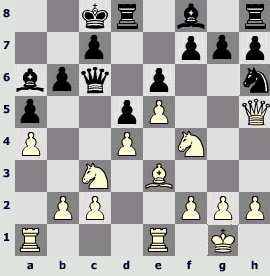
14. . . . g7-g6?!
Boris Gulko "rose to it", overlooking or underestimating the strong response of the opponent. As he fairly pointed, in case of 14...Ґb4! 15.¤d3 [15.¤fe2 ¤f5µ] 15...Ґ:c3 16.bc ¤f5 Black would stand perfectly.
15.Јh5-d1! ¤h6-f5
And now it's impossible to pin the Knight c3 because 15...Ґb4? 16.¤:e6 fe 17.Ґ:h6 Ґ:c3 18.bcЈ:c3 19.¦e3 Јc6 20.¦f3 leads to the difficult for Black position.
16.¤c3-e2! h7-h5
17.c2-c3 g6-g5
18.¤f4-d3 Јc6-c4
19.¤e2-c1 Ґf8-e7
An immediate exchange of light pieces 19...¤:e3?! 20.¦:e3 g4 gave the opportunity for White to begin a dangerous attack on the queenside: 21.b4! ab [21...Ґh6? 22.¤b2 Јc6 23.b5ќ; 21...Ј:c3? 22.¤e2ќ] 22.¤:b4 Ґh6 [or 22...Ґ:b4 23.cbЈ:b4 24.a5] 23.¦d3 with subsequent 24.a5.
20.Јd1-d2
White is planning an advance of the pawn "b", which is impossible at the moment (20.b4 Ј:c3).
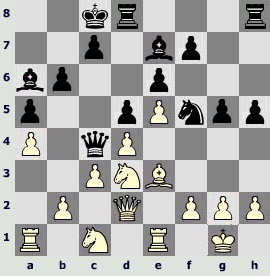
20. . . . ¤f5:e3
Here the exchange is more appropriate, than at the previous move. In case of 21.¦:e3 g4 White is to reckon with the danger of 22...Ґg5, in addition the Knight d3 is fixed because of the checkmate at f1. An unclear position arises in case of 21.feЈc6 22.b4 Ґc4.
21.¤d3-c5!?
It's ingenious combination. White cuts off the opponent's Queen retreat and entraps it by the move b2-b3. Black is to chose an optimal way of sacrificing the Queen among several possibilities.
A maximum of the material for the Queen Black can get in the variant 21...bc 22.b3 Јf1+ 23.¦:f1 ¤:f1 24.Јc2 cd. However only for the time being – the Knight f1 will be inevitably lost and weakness of the pawns cover of the black King may tell.

There appear the following variants:
А) 25.c4?dc 26.bcd3! 27.¤:d3 ¦d4 [27...¤d2? 28.Ј:d2 Ґ:c4 are bad in view of 29.Јc3 Ґ:d3 30.Јc6 and 31.¦c1] 28.¦:f1 ¦hd8! [28...Ґ:c4? 29.¦c1! withadvantageofWhite; 28...¦:c4 29.Јe2! ¦d4 (29...g4 30.¤b2 ¦c6 31.Јe4 Ґb7 32.Јf4± are weaker) 30.Јf3 with unclear play] 29.¤b2 ¦d2 [29...Ґa3!µ] 30.Јb3 Ґc5, and the advantage is on the side of Black.
B) 25.¤d3?! dc 26.Ј:c3 [26.¦:f1 d4µ]
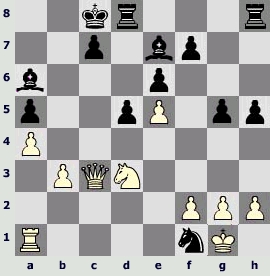
Gulko proceeds with 26...Ґb4 27.¤:b4 ab, contrary to his opinion the position of Black is difficult here. For example 28.Ј:b4!? d4 is possible (іGulko) 29.¦c1! ¦d7 30.Јb6 Ґb7 31.ў:f1 d3 32.Јe3±. In his main variant 28.Јc6 Ґb7 29.Јb5 ¤d2 there is no need for White to play a double-edged game after 30.a5 ¤:b3 – 30.Ј:b4! ¤e4 31.f3± are far stronger. The same idea can be arranged a bit differently: 29.Јc2!? (instead of 29.Јb5) 29...Ґa6 30.¦c1 ¦d7 31.Јc6 Ґb7 32.Јb5! ¤d2 33.Ј:b4 [33.a5 ¤:b3 34.a6 c5! are unclear] 33...¤e4 34.f3 with advantage.
So, the move 26...Ґb4? doesn't help to rescue the strayed Knight, that's why the exchange of the important Bishop should be rejected in favour of 26...d4!. Here are some crude variants that are for sure not forced but rather interesting:
а) 27.Јc6 Ґb7 [27...Ґ:d3? 28.¦c1ќ] 28.Јc2 ¤:h2!? 29.ў:h2 g4 30.¦c1 ¦d7 31.Јd2 h4 32.Ј:a5
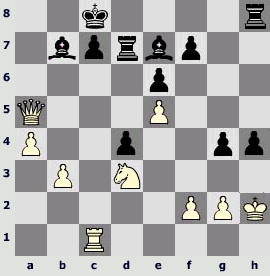
32...g3+! 33.fg hg+ 34.ў:g3 Ґh4+! [34...¦g8+ 35.ўf2 ¦:g2+ 36.ўf1 ¦h2 37.Јb5! are less convincing, and if 37...Ґh4?! with the danger of 38...Ґf3, then 38.¦c6!] 35.ўf4 [35.ўg4 f5+ 36.efҐ:f6°] 35...¦g8 36.g4 Ґg5+ 37.ўg3 Ґ:c1 38.¤:c1 d3°;
b) 27.Јc2¤e3!? [27...¤:h2!?] 28.fede 29.¦c1 ¦d7 30.¤c5 [30.Јc6!? Ґb7 31.Јb5 ¦hd8 32.Ј:a5] 30...¦d2 31.Јc3 ¦hd8 32.Ј:e3 ¦d1+ 33.¦:d1 ¦:d1+ 34.ўf2 ¦f1+ 35.ўg3
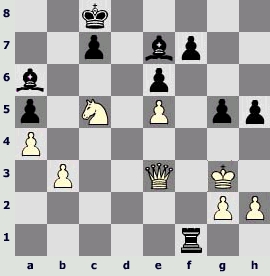
35...f5! 36.ef Ґd6+ 37.ўh3 ¦f3+!! 38.Ј:f3 [38.gf Ґf1#] 38...g4+ with a win.
c) 27.Ј:a5! Ґ:d3 28.¦c1 [28.¦d1 Ґe4 is worse]
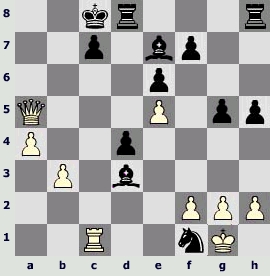
Exactly this way, rushing to the desperate counter-attack without taking into account any material losses, White creates a counter-play that allows him to keep the balance. To 28...ўd7?! it's unpleasant 29.¦:c7+ ўe8 30.Јa7, for example: 30...Ґa3?! 31.b4! Ґ:b4 32.Јb7 Ґa3 33.Јf3 Ґe7 34.Ј:d3ќ. If 28...c5, then 29.b4! [29.Јa7 ¤d2!] 29...ўd7 30.bc ўe8 31.c6 ўf8 32.c7 ¦c8 33.Јb6 ўg7 34.Ј:d4=.
C) He shouldn`t be hasty in winning back the Knight. Instead of 25.c4? or 25.¤d3?! it should be played simply and solely 25.cd!. From the danger 26.¤d3 there is only one defense: 25...Ґb4, but then White proceeds with 26.¤a2! [26.Јc6 Ґb7 27.Јb5 ¤d2 or 26.¤d3 Ґ:d3 27.Ј:d3 ¤d2 are weaker] 26...ўb7 27.¤:b4 ab, and in case of 28.Јc5 ¦b8 pointed by Gulko, the advantage will be kept; however it's far more convincing to play 28.¦c1! ¦c8 29.Јc6+ ўa7 30.¦c5 ¦b8 31.¦a5 ¦b6 32.Ј:c7+ ¦b7 33.Јc1 with the win.
We can draw a conclusion that 21...bc? leads Black to a difficult position.
21. . . . Ґe7:c5!?
When commenting the game Gulko gave two exclamation marks to the move he made himself. May be he was wrong, because there was a worthful alternative: 21...¤g4!! 22.b3 Ј:c5! 23.dc Ґ:c5

24.¦e2 Ґ:e2 25.Ј:e2 ¤:f2 leads to the advantage of Black [25...Ґ:f2+ 26.ўh1 d4 27.¤d3 Ґe3 28.c4 f6 29.ef ¦hf8µ are also not bad] 26.b4 ab 27.cbҐd4 28.¤b3!? ¤h3+!? 29.ўf1 Ґ:a1 30.gh Ґc3 31.a5 ўd7!?. That's why White plays24.¤d3!? Ґ:d3 25.Ј:d3. In case of incautious 25...¤:f2? 26.Јa6+ ўb8 27.b4! ab 28.a5! [or 28.cbҐd4 29.ўf1] he launches a counter-attack. 25...Ґ:f2+ 26.ўh1 Ґ:e1 27.Јa6+ ўb8 28.¦:e1 d4 are correct [28...¤f2+ 29.ўg1 ¤e4 30.b4 are unclear] 29.h3 ¤e3 [29...¤h6? 30.b4 are not correct (30.c4 and 31.c5) 30...ab (30...dc 31.ba) 31.a5!, and the black Knight is in danger] 30.cd
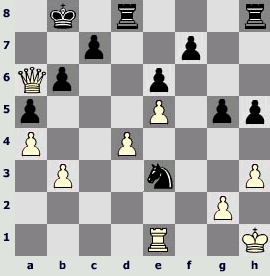
Black has a perfect position. The only point is which continuation will provide the most hard-set advantage for him.
I've analyzed the way of playing in case of 30...¤c2 31.¦f1:
31...¦d7 32.Јb5 ¦d5! [32...¦hd8 33.Јe2 ¤:d4 34.Ј:h5 ¤:b3 35.Ј:g5 less exact] 33.Јd3 ¤:d4 34.¦:f7 ¤c6›;
31...¤:d4 32.b4 [32.¦:f7 ¤:b3і] 32...ab 33.a5 b5 34.¦d1 и 35.¦:d4›.
If the results of these variants don't satisfy Black, he has a right to try 30...¤f5!?, or even restrained 30...¤d5!?, in order to prevent any counter-attack concerned with b3-b4 forever.
22.b2-b3 Ґc5-e7!?
Black agrees to the position with two Bishops for the Queen. It's an interesting, but not a forced decision at all. Although 22...¤f1? 23.Јc2 Ј:c3 24.Ј:c3 Ґb4 25.Јc6 Ґb7 26.Јc2± were not suitable, there was a good alternative position in case of 22...Јf1+! 23.¦:f1 ¤:f1 24.Јc2 Ґe7 25.¤d3 [25.h3 g4 26.¤e2 gh 27.gh ¦dg8+ 28.ў:f1 ¦h6 29.c4 ¦hg6 look risky] 25...¤:h2 26.ў:h2 g4. Black has a Rook, a Bishop, a pawn for the Queen and a prospect of an attack against the opponent's King.
23.b3:c4 ¤e3:c4
24.Јd2-c2 g5-g4!
25.¤c1-d3 ¦d8-g8

26.¤d3-b2?
An exchange of the strong Knight of the opponent certainly suggested itself, but I think it should have been declined.
The problem of White is that he has nowhere to show some activity now, while the opponent can strengthen the position advancing the pawns of the kingside, moving the Rook to f5 and the Bishop to g5. It's far easier to play with Black pieces and such a situation is psychologically unpleasant for the opponent, it`s fraught with losing some orienting points and as a result with increasing probability of mistakes.
It would be desirable for White either to open a line for his Rooks at the kingside or on the contrary to close the kingside in order to deprive the opponent of attacking possibilities. Anoriginalplan26.ўh1!? h4 27.¦g1 with the idea f2-f4 suggested by Ilaha Kadimova might have been tried. To 27...g3 comes 28.h3, and the line "f" opens for white pieces. If 27...h3, then 28.g3 ¦h5 [28...Ґg5 29.¤f4] 29.¤f4 ¦f5 30.Јd1!?, preparing f2-f3. There arises difficult and what is very important, a double-edged situation.

However the same problem could be solved far more simply: 26.¦e2! h4 27.¦f1 ¦h5 [27...h3 28.g3] 28.f4. It's risky to beat when passing, opening for the opponent the «f» line and after 28...¦f5 a draw is the most probable result, because the position is too closed.
26. . . . ¤c4:b2
27.Јc2:b2 h5-h4
28.Јb2-c2
The sacrifice of a pawn 28.c4!? is interesting, and if 28...Ґ:c4, then 29.¦ec1 with the idea 30.¦:c4 dc 31.¦c1. But black could respond 28...dc!?.
28. . . . ¦h8-h5
29.¦a1-b1 Ґa6-c4!
Otherwise the move ¦b1-b5! should have been taken into account!. White has no useful ideas any more, he is only to bide his time.
30.¦e1-e3 Ґe7-g5
It would be natural to play 30...¦f5 first, but Gulko seemed to be hesitated over response 31.Јd1, impeding the Bishop's going out.
31.¦e3-d3 Ґg5-h6
Certainly not 31...Ґ:d3? 32.Ј:d3, and the advantage passes to White. Bishops here are more valuable than useless white Rooks.
32.¦b1-f1 ¦h5-f5

33.g2-g3?!
33.h3? is unfavorable ¦fg5µ with the attack against square g2.
To 33.f3 Gulko points out 33...ўb7, and rejects 34.fg? because of 34...Ґe3+!. But White is preparing a capture at g4 by the move 34.Јd1!, for example: 34...Ґf4!? 35.fg ¦:g4 36.ўh1. Instead of an inert 33...ўb7 33...f6!? 34.ef ¦:f6 deserves attention with subsequent ¦gf8. For example, 35.g3!? (with the idea f3-f4) 35...hg 36.hg Ґf4! 37.fg ¦:g4, and Black holds the initiative.
It's not easy to estimate whether it made sense for White to use a delaying tactics: 33.¦dd1. Gulko intended to strengthen the position by means of 33...h3 34.g3 ¦f3 with subsequent ¦g8-g5-f5. To 35.¦fe1 it's necessary to act unhastingly (35...ўb7), because to 35...¦g5?! thereisaresponse 36.Јh7. If the black Rook manages to reach f5, then a further plan may concern undermining f7-f6 in an opportune moment and (after an exchange of pawns at f6) e6-e5.
33. . . . ¦g8-h8!
Black switches to the attack along the file "h".
34.¦f1-d1 ¦f5-h5
35.Јc2-e2 h4:g3
36.f2:g3
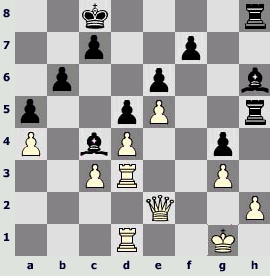
36. . . . Ґh6-e3+!!
37.Јe2:e3
A lost four Rook ending without a pawn arose in case of 37.¦:e3 Ґ:e2 38.¦:e2 ¦f5. An interesting ending appeared after 37.ўh1 ¦:h2+ 38.Ј:h2 ¦:h2+ 39.ў:h2 Ґg5!.
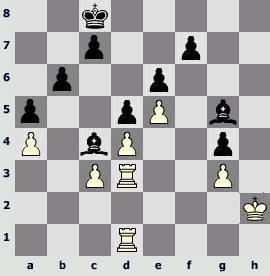
To 40.¦3d2 Gulko points out a winning variant 40...Ґ:d2 41.¦:d2 Ґb3 42.¦f2 Ґ:a4 43.¦:f7 Ґc2! [43...Ґb5!? is no less strong]. That's why White plays 40.ўg2, without fear of 40...Ґb3 41.¦a1! [but not 41.¦f1? Ґ:a4 42.¦:f7 Ґc2°]. Black forms a passed pawn by means of 40...b5! 41.aba4. Here is an analysis by Gulko:
42.b6 a3! 43.¦3d2 [43.ўf2 Ґ:d3 44.¦:d3 Ґc1°] 43...Ґb3°;
42.ўf2 Ґ:d3! 43.¦:d3 Ґc1!°;
42.¦3d2 Ґb3!°.
In my opinion the recommended move of Black in the last variant (inviting a danger 43...Ґ:d2 44.¦:d2 a3 45.¦f2 a2 46.¦f1 Ґc2°) is not the strongest one – simpler are 42...Ґ:d2 43.¦:d2 ўb7 44.ўf2 a3 45.ўe3 ўb6°. However it's also sufficient for a win: 43.¦d3 ўb7 44.ўf2 ўb6 45.ўe2 ў:b5 [but only not 45...a3? 46.¦a1 a2 47.¦d2, and after the exchange at d2 the white King moves to b2] 46.¦b1 ўc4 47.¦a1 Ґc2 48.¦d2 Ґ:d2 49.ў:d2 ўb3°.
So, an immediate transition into the ending leads to win. Besides Black has a right to try to get an ending with extra tempo, having chosen 37...¦h3!? [but only not 37...ўb7? in view of 38.h4!] 38.Јg2 (there was a danger of 38...¦:g3) 38...Ґg5. To 39.¦3d2 the most simple is 39...Ґ:d2 40.¦:d2 ¦:h2+ 41.Ј:h2 ¦:h2 42.¦:h2 [42.ў:h2 Ґb3°] 42...b5 43.ab a4 44.ўg2 a3 45.¦h1 a2 (with the dander of 46...Ґd3) 46.¦a1 ўb7°. It's winning also 39...Ґb3 40.¦b1 Ґ:d2 41.¦:b3 Ґe1 42.ўg1 ўb7!, and White has nothing to move with: 43.¦a3 ¦8h5 44.¦b3 ¦f5° or 43.Јe2 Ґ:g3 44.Ј:g4 Ґ:h2+ 45.ўf2 ¦8h4°.
37. . . . ¦h5:h2
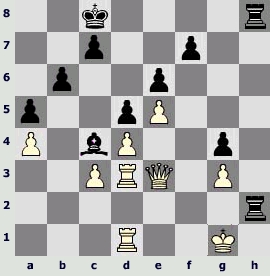
38.Јe3-g5?
38.Јf4 ¦h1+ 39.ўf2 ¦8h2+ 40.ўe3 ¦:d1 41.¦:d1 ¦e2# led to a checkmate. To 38.¦f1 38...¦8h5 was decisive with subsequent 39...¦h1+ 40.ўf2 ¦f5+. But the move in the game is also not better.
The only protection from immediate defeat was a beautiful move 38.Јd2!!. Blackresponded 38...¦:d2 [38...¦h1+? 39.ўf2 ¦8h2+ 40.ўe3 ¦:d2 41.¦3:d2 are far weaker] 39.¦3:d2 b5!? (Gulko). An advantage was undoubtedly on the side of Black, but the struggle was still going on.
38. . . . Ґc4:d3
39.¦d1:d3
A checkmate arrives also in case of 39.¦d2 ¦h1+ 40.ўf2 ¦f1+ 41.ўg2 ¦f5 42.Ј:g4 Ґe4+ 43.ўg1 ¦h1#.
39. . . . ¦h2-h1+
40.ўg1-f2 ¦h8-h2+
41.ўf2-e3 ¦h1-e1+
White resigned a move before a checkmate (42.ўf4 ¦e4#).
Anand – Topalov B90
Linares 1998
(on a basis of the commentary by Viswanathan Anand)
1.e2-e4 c7-c5
2.¤g1-f3 d7-d6
3.d2-d4 c5:d4
4.¤f3:d4 ¤g8-f6
5.¤b1-c3 a7-a6
6.Ґc1-e3 ¤f6-g4
7.Ґe3-g5 h7-h6
8.Ґg5-h4 g7-g5
9.Ґh4-g3 Ґf8-g7
10.Ґf1-c4 ¤b8-c6
11.¤d4:c6 b7:c6
12.h2-h4
In a rapid game between the same chess players that took place the same year, 1998 during the tournament in Monaco Anand tried 12.Јf3, and after 12...¦f8! [12...0-0 13.h4 are far weaker] 13.Ґb3 ¤e5› he gained nothing.
12. . . . Јd8-b6
13.Ґc4-b3
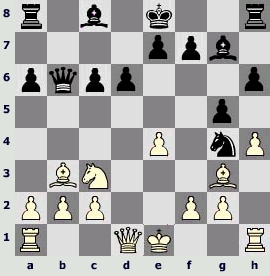
Strategically the position of Black is very good: he controls dependably the central squares, the black square Bishop is strong, the Knight will occupy an excellent square e5. The only problem is how to complete successfully the development (by means of a long castling), without losing one of the exposed pawns of the kingside or at least having received a positional compensation for it.
A successful way of solving the problem was demonstrated in the game van den Doel – Lutz (Bad-Zwesten 2000, 77/235): 13...¦f8! 14.hghg. Moves 15.¦h7 or 15.¦h5 can be parried by means of 15...Ґ:c3+ 16.bc ¤f6 with advantage of Black.15.Јf3 ¤e5 is useless. And to 15.Јd2 came 15...a5! [15...Јc5!? 16.¤a4 Јd4 are also not bad] 16.Ј:g5? Ґe5! 17.Ґh4 [ but not 17.Ґ:e5? Ј:f2+, to 17.0-0-0 17...Ґf6 18.Јd2 a4 19.¤:a4 ¦:a4 turn the scale and 17.Јd2 Ґ:g3 18.fg ¤e5 leads to a better position of Black] 17...Ґf6 18.Јd2 [18.Јf4 ¦h8 19.g3 a4! 20.¤:a4 ¦:a4 21.Ґ:a4 Јb4+ 22.c3 Ј:a4 with an attack of Black] 18...¦h8 19.g3 Ґ:c3 20.bc [or 20.Ј:c3 Ј:f2+ 21.ўd1 ¤e5µ] 20...¤e5, and Black has an obvious advantage.
Instead of a mistaken capture of the pawn g5 it should be chosen 16.a4Јc5 17.f3 Јe3+ 18.Ј:e3 ¤:e3 19.ўd2 [19.ўf2? Ґd4] 19...¤:g2 20.¦ag1 ¤f4 21.Ґ:f4 Ґ:c3+ 22.ў:c3 gf 23.¦g7 with equality (analysis by Christopher Lutz).
However the method of defense chosen by Veselin Topalov is also rather possible.
13. . . . Ґc8-d7
14.h4:g5 0-0-0!
In case of 14...hg 15.¦:h8+ Ґ:h8 16.Јf3 Black runs into difficulties: the square f7 is attacked, it's undesirable to put the knight at f6 (the square e5 is destined for it), it's even more undesirable to close the diagonal for the Bishop by the move f7-f6. An attempt to solve the problem tactically: 16...0-0-0 17.Ј:f7 ¤e3!? – after 18.Ј:e7 18...¤:c2+? 19.Ґ:c2 Ј:b2 doesn’t work in view of 20.Ј:d6 Ґ:c3+ 21.ўf1 Ј:a1+ 22.Ґd1ќ; in case of 18...Ґ:c3+ 19.bcЈc5 20.ўd2 White holds the advantage, and to 18...Јc5 he may choose between 19.ўd2 and 19.feҐ:c3+ 20.ўf1± (analysis by Dvoretsky).
Having made long castling Black joined two Rooks: now he is ready to take at g5, and in case of exchange at h8 – to beat by the Rook. It's too risky for White to win a pawn: 15.gh?! Ґ:h6 16.Јf3 Ґg5 – because his King gets stuck in the centre of the board.
After 15.Јf3 hga capture of the pawn f7 is impossible, and to 16.0-0-0 come 16...Ґe5! 17.¦:h8 [17.Ґ:e5 ¤:e5 18.Јe2 f6і] 17...¦:h8 18.Ј:f7 Ґ:g3 19.fgЈe3+ 20.ўb1 ¤f2 21.¦c1 [21.Јg7 ¦h2] 21...¤:e4, and everything is all right with Black.
15.Јd1-d2 h6:g5
16.¦h1:h8
There was an alternative move 16.0-0-0. In response the pawn g5 should not be primitively defended by 16...¦:h1 17.¦:h1 Ґ:c3 18.bc! f6, because 19.¦h7 gives an advantage to White. Anand recommends 16...Ґ:c3, but overestimates the position of Black both in the variant 17.bcf6 18.f3 Јe3! 19.¦:h8 ¦:h8 20.Ј:e3 ¤:e3 21.¦g1 d5 (µ Anand) 22.Ґf2 ¤c4 23.Ґc5 e5 24.Ґ:c4 dc with equal ending, and after 17.Ј:c3 ¦:h1 18.¦:h1 ¤:f2 (µ Anand) – White proceeds with 19.Ґ:f2 Ј:f2 20.Јa5 with a counter-play.
Black can also play 16...Ґe5!?17.Ґ:e5 ¤:e5 18.¦:h8 [18.Ј:g5 Ј:f2 19.Ј:e7 Ґg4!] 18...¦:h8, getting the position that will be analyzed in the next comment.
16. . . . ¦d8:h8
17.0-0-0

There is no danger of a capture at g5 yet, but the pawn f7 is en prise. And in the meantime White is planning to improve his position by f2-f3 and Ґf2. What to counter with this?
17. . . . ¤g4-e5?!
Black secures his pawns, but he doesn't struggle against the main plan of the opponent and as a result soon he faces difficulties. It was necessary to move 17...Ґe5!.
А) 18.Ґ:f7Ґ:g3 19.fgЈe3 with equality – the extra pawn of White is of no importance.
B) 18.Ј:g5Ґ:g3 19.fgf6 20.Јg7 Јd8 and 21...Јf8 with approximately equal chances. Besides, there are 19...Јe3+!? 20.Ј:e3 ¤:e3. After 21.¦e1 ¤g4 22.Ґ:f7 Anand cuts the variant with an estimation "advantage of White". Let'scontinueitand see the next move: 22...e6! (with an idea 23...¤e5) – the Bishop falls into a trap and the estimation changes to the opposite one.
C) 18.Ґ:e5 ¤:e5 19.Ј:g5 Ј:f2 20.Ј:e7 Ґg4! 21.Ј:d6 [21.¦:d6? ¦h1+ 22.¤d1 Јf4+ 23.ўb1 ¦:d1+ 24.¦:d1 Ґ:d1 are bad] 21...Ґ:d1 22.Ј:e5 ¦h1 23.Јe8+ ўc7 24.Јe7+ ўc8, and White is to content himself with a perpetual check.
18.f2-f3!
The plan of White is clear: 19.Ґf2, then ¤a4 (examining the square b6), Ґe3 etc.
18. . . . Јb6-a5
19.ўc1-b1 Ґg7-f6
The capture at g5 has at last become a danger.
20.Јd2-e3!
Preventative measures! An immediate 20.Ґf2 would be met with the move 20...c5, to which there should be a response ¤d5, which is of no use because of the exchange of the Queens. On the other hand, 20...c5? 21.¤d5 are already bad.
20. . . . ўc8-b7
21.Ґg3-f2 ¦h8-b8
Of course it’s necessary to be protected against the check at а7, but in the opinion of Anand it's better to do by means of 21...¦a8. There was an active possibility of 22...Јc7 and 23...a5.
Now White starts to prepare an advance f3-f4, driving the Knight out off the central square е5.
22.g2-g3 ўb7-c8
23.Јe3-e2?!
Anand gives two exclamation marks to this move, and apparently he is wrong. 23.Ґe1!? Јb6 24.Јe2 would be more exact, for example: 24...Ґe6!? 25.Ґ:e6+ fe 26.b3, and the position of White remains more preferable.
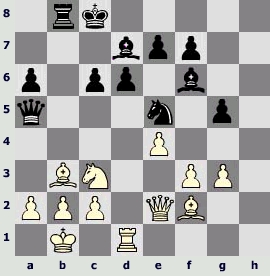
23. . . . ¤e5-g6?
White indiscreetly gave the opponent an opportunity to advance the pawn "c" with impunity, and he should have taken this opportunity. After23...c5! 24.¤d5? c4 doesn’t work, that's why 24.Ґe1 should be played. In response the sacrifice of the pawn 24...c4?! 25.Ґ:c4 ¤:c4 26.Ј:c4+ ўd8 is dubious in view 27.a4! with subsequent 28.b3 [but not immediately 27.b3?! ¦c8 28.¤d5? (28.Јd5 Јc7 29.e5! Ґ:e5 30.¦d3 would be better) 28...Јa3°]. Butthereis24...Ґb5! 25.¤:b5 Ј:b5 26.c4 Јd7, and Black keeps up an approximate equality. The game can develop this way: 27.Ґc3 Јh3 28.f4 Јg4 29.Јf1 gf 30.gf ¤d7 31.e5!? [31.Ґ:f6 ¤:f6 32.¦e1 ¤h5 33.Ґd1 Јh4 34.Ґ:h5 Ј:h5І are not very promising] 31...de 32.fe ¤:e5 [stronger than 32...Ґ:e5, in response to which both 33.Ґa4 ¤f6!? 34.Јh1! and 34.Ґ:e5 ¤:e5 35.Јf2! or 34...Јe4+ 35.ўa1 Ј:e5 36.Ј:f7 are unpleasant] 33.¦d5 ¤d7 34.Ґ:f6 [34.Ґa4 ¦b7 35.Ґ:f6 ¤:f6 35.¦:c5+ ўb8 are also unclear] 34...Јg6+ 35.ўa1 Ј:f6 36.¦f5 Јe6 37.¦:f7 ¤f6=.
24.Ґf2-e1 Јa5-b6
25.¤c3-a4 Јb6-b5
To 25...Јb7 26.Ґc4! is correct, but not 26.Ґa5 Јb5, and it's bad 26...Ґ:b2 27.Ґ:a6.
26.c2-c4 Јb5-b7
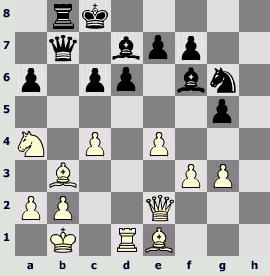
27.Ґe1-a5??
A winning position could be provided by 27.c5!. I saw that move, but finally decided to "simply win the queen" – a decision that still baffles me.Variants are simple: 27...Ґe6 28.Ґ:e6+ fe 29.cd [or 29.¤b6+ ўd8 30.Ґa5 ўe8 31.f4!]; 27...Јb5 28.Јc2 Ґe6 29.Ґ:e6+ fe 30.cd – in any case the game would be soon over.
27. . . . c6-c5!
28.¤a4-b6+ Јb7:b6
29.Ґa5:b6 ¦b8:b6

Here I began to have the sinking feeling that I made the wrong decision on move 27 and I started to drift.
30.¦d1-d2?
"Mistake never comes alone". Consciousness of the mistake often distorts a normal train of thought, undermines self-reliance, as a result the probability of new blunders increases. This is what happened in this case: Anand takes measures against a6-a5-a4, strengthening the square b2, but gives the opponent time to consolidate his forces.
The position required energetic actions in the centre: 30.Јe3! a5 31.f4 gf 32.gfa4 33.e5!. It was my original idea and the reason I selected 27.Ґa5.But while I was thinking about 30.Јe3, I wondered "What happens after 33...¤:e5!" ?
All the other attempts of Black are absolutely hopeless: 33...de 34.Ј:c5+ [or 34.¦:d7 ў:d7 35.Ј:c5] 34...¦c6 35.Јa7; 33...Ґg7 34.Ґc2; 33...ab 34.efba+ 35.ўa1. And after 33...¤:e5! 34.feҐ:e5 White has a choice:

А) 35.¦d5 (the best move in Anand’s opinion) 35...ab 36.¦:e5 [36.abf6] 36...ba+ 37.ўa1! [in case of 37.ў:a2 de 38.Ј:c5+ ¦c6 the black Rook will inevitably take at c4, even after 39.Јa7 – and will be invulnerable in view of Ґe6] 37...de 38.Ј:c5+ ¦c6 39.Јa7! [a capture of any pawn is weaker because of 39...¦:c4; it's impossible to beat now at с4 in view of 40.Јa6+]. White's threat of b4-b5 is very strong, but Black has a lot of pawns as well!
B) 35.Ґc2 Ґ:b2 36.Јf3 Ґa3+ 37.Ґb3 ўc7 38.Ј:f7 ab,...and I was not sure about this type of position.Let's continue the variant: 39.Ј:e7 ba+ 40.ў:a2 Ґb4 41.¦h1. IftheBishop had time to move to е5, Black would construct an effective defense. But there is no time for this movement: there is a danger of 42.¦h7, the black Rook can't defend both weak squares d7 and d6 alone (to 41...¦b8 42.¦h6 turns the scale). It means that the move 35.Ґc2! is stronger than 35.¦d5!?.
30. . . . Ґf6-e5!
Now in order to play f3-f4, White is to worsen the disposition of his pieces and to spend time, as a result Black has enough time to meet this advance fully armed.
31.Јe2-h2 ўc8-c7
32.¦d2-f2 ¦b6-b8!
Black has full equality now. White has nothing better to do than f3-f4.
33.f3-f4
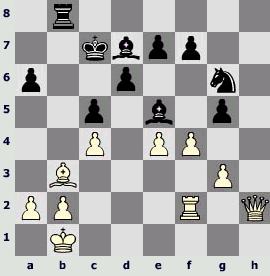
33. . . . ¦b8-h8?!
The move in the game changes the situation: White gets back the Queen and has the ending with extra exchange. A general rule that can be also applied here says: "Defending the worst endings try to exchange as many pawns as possible". From this point of view it made sense to insert 33...gf! 34.gf, and only after that to play 34...¦h8 [apparently it's weaker to play 34...Ґd4 35.Јg3!І: it's undesirable to exchange the powerful Bishop for the Rook, and 35...¦h8 is useless because of 36.¦h2]. There would come 35.fe¦:h2 36.ed+ ў:d6 37.¦:h2 Ґc6І...withabetterversionofthegame. White has more resources with pawns on g5 and g3.
34.f4:e5 ¦h8:h2
35.e5:d6+ ўc7:d6
36.¦f2:h2 Ґd7-c6
37.Ґb3-c2
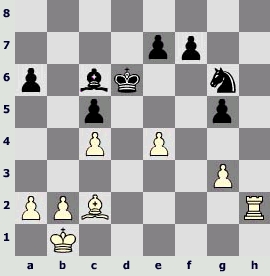
37. . . . ¤g6-e5
Here Anand gives a short comment: 37...ўe5? 38.¦f2!. I couldn't interpret it: it's not clear what will come to 38...f6 and why an obvious move 38.¦h7 is worse.
38.b2-b3 ¤e5-f3
39.¦h2-h7 f7-f6
40.ўb1-c1 a6-a5
Blackhasanextremelygoodfortress; clearly, Whitecan't make a progress on the kingside. However, White has an extra pawn on the queenside, so the first step is clear – get the king to c3 and play for b3-b4.
41.ўc1-d1 ўd6-e6
42.Ґc2-d3
Certainly not 42.ўe2?? ¤d4+! and 43...¤:c2.
42. . . . ўe6-d6
43.ўd1-e2 ¤f3-e5
44.ўe2-d2 Ґc6-b7
45.ўd2-c3
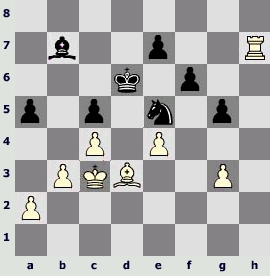
45. . . . ¤e5-c6?!
The Knight shouldn't be taken away from the square e5for the time being. The point is that White can't play a2-a3 and b3-b4 as his King is defending the Bishop d3. If the bishop retreats to с2, then the move ¤c6 will become appropriate. And now it is untimely, because White has an opportunity of the maneuver 46.Ґf1! and 47.Ґg2. In case when the Bishop is at g2 it's hardly possible to prevent pawns advance at the queenside, in case of retreat of the Knight to с6 it's necessary to reckon with e4-e5+.
Anand didn't make use of the opponent`s inaccuracy immediately, but a move later the latter any way made it possible to move the Bishop to a better position.
46.¦h7-h8? ўd6-c7?
46...¤e5! is correct.
47.Ґd3-f1! ¤c6-e5
48.Ґf1-g2 Ґb7-c6
49.a2-a3 Ґc6-b7
50.¦h8-h7! ўc7-d7
51.b3-b4 a5:b4+
52.a3:b4 c5:b4+
53.ўc3:b4 Ґb7-a6
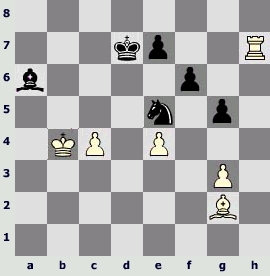
The pawn is en prise, an advance leads to the loss of it: 54.c5? ¤d3+ 55.ўa5 ¤:c5 56.ўb6 ўd6 57.¦h6 (with the danger of 58.e5+) 57...e6!. To 54.Ґf1 comes 54...Ґb7 – the Bishop is unable to defend both pawns at a time. What's to be done? Anand finds an elegant solution.
54.Ґg2-h3+!
To pry open the fifth rank.
54. . . . g5-g4
54...ўd6 55.c5+ or 54...ўd8 55.Ґe6 are hopeless.
55.Ґh3-f1 Ґa6-b7
56.Ґf1-g2 Ґb7-a6
57.¦h7-h5!
That's the point! The Rook helps the pawn. There is neither 57...Ґ:c4 58.¦:e5, nor 57...¤:c4 58.Ґf1. Moreover Black is unable even to create a danger of capture at c4, it means that White will have time to bring the King back to c3 consolidating the position.
57. . . . ўd7-e6
58.ўb4-c3 ўe6-d6
59.Ґg2-f1 Ґa6-b7
60.Ґf1-d3 Ґb7-c6
61.¦h5-h7 Ґc6-d7
62.Ґd3-e2 Ґd7-e6
63.Ґe2-f1 Ґe6-f7
64.Ґf1-d3 Ґf7-e6
65.¦h7-h8
When the Rook gets to a8, White should be able to advance his passed pawn.
65. . . . ¤e5-c6
66.Ґd3-c2 ўd6-c5
67.Ґc2-b3!
A minute stoppage on the way to the desirable square a4 (67.Ґa4 ¤e5 is untimely). Blackisdefenseless. To 67...¤e5 68.¦h7! ¤c6 69.Ґa4 turn the scale; to 67...Ґd7 – also 68.Ґa4.
67. . . . Ґe6-f7
The Rook gained access to the square с8, that's why the Bishop mustn't defend the pawn c4 any more.
68.Ґb3-a4! ¤c6-e5
69.¦h8-c8+ ўc5-b6
70.c4-c5+ ўb6-b7
71.¦c8-h8 Ґf7-g6
72.ўc3-d4 Ґg6-f7
73.¦h8-h7 ўb7-c7
74.Ґa4-b5 ¤e5-f3+
75.ўd4-e3 ¤f3-e5
76.¦h7-h8 Ґf7-g6
77.¦h8-a8 ўc7-b7
78.¦a8-a6
Black resigned.
